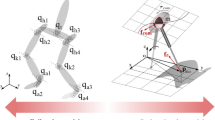Abstract
In this paper, the trajectory generation problem for a bipedal walking robot traversing uneven terrain is considered. Most of the well-tested approaches to walking over flat terrain are based on zero-moment point (ZMP) principle, often in combination with linear inverted pendulum model. These approaches cannot be directly transferred to uneven terrain because ZMP conditions require the supporting surface to be flat and horizontal and with sufficient friction to prevent feet slip**. In this paper, a way to generalize these approaches to uneven terrain with unknown tribological properties is given. The approach is based on numerically checking which starting points for the ZMP, and the center of mass trajectories are admissible for the given terrain. These points form convex regions, which can be explicitly included in real-time trajectory planning procedures. In order to take into account the fact that the exact properties of the supporting surface are unknown, the parameters of the surface can be varied to find robust admissible ZMP regions, as discussed in the paper. Examples of the use of admissible ZMP regions are given.
Access this chapter
Tax calculation will be finalised at checkout
Purchases are for personal use only
Similar content being viewed by others
References
Vukobratović, M., Borovac, B.: Zero-moment point-thirty five years of its life. Int. J. Humanoid Rob. 1(01), 157–173 (2004)
Kajita, S., et al.: Biped walking pattern generator allowing auxiliary ZMP control. In: 2006 IEEE/RSJ International Conference on Intelligent Robots and Systems, pp. 2993–2999. IEEE (2006)
Kajita, S., et al.: Biped walking pattern generation by using preview control of zero-moment point. ICRA 3, 1620–1626 (2003)
Kuindersma, S. Permenter, F., Tedrake, R.: An efficiently solvable quadratic program for stabilizing dynamic locomotion. In: 2014 IEEE International Conference on Robotics and Automation (ICRA), pp. 2589–2594. IEEE (2014)
Khusainov, R., Sagitov, A., Klimchik, A., Magid, E.: Modelling of dynamically stable AR-601M robot locomotion in Simulink. In: MATEC Web of Conferences, vol. 75, p. 09004 (2016)
Caron, S., Pham, Q.C., Nakamura, Y.: Stability of surface contacts for humanoid robots: Closed-form formulae of the contact wrench cone for rectangular support areas. In: 2015 IEEE International Conference on Robotics and Automation (ICRA), pp. 5107–5112. IEEE (2015)
Hirukawa, H., et al.: A universal stability criterion of the foot contact of legged robots-adios ZMP. In: Proceedings 2006 IEEE International Conference on Robotics and Automation ICRA, pp. 1976–1983. IEEE (2006)
Sugihara, T., Nakamura, Y., Inoue, H.: Realtime humanoid motion generation through ZMP manipulation based on inverted pendulum control. ICRA 2, 1404–1409 (2002)
Bretl, T.W., Lall, S.: Testing static equilibrium for legged robots. IEEE Trans. Rob. 24(4), 794–807 (2008)
Zamparelli, A., Scianca, N., Lanari, L., Oriolo, G.: Humanoid gait generation on uneven ground using intrinsically stable MPC. IFAC-PapersOnLine 51(22), 393–398 (2018)
Jatsun, S. Savin, S., Yatsun, A.: Harmonic function-based ZMP trajectory generation for nonlinear motion of walking robots. In: 2018 International Russian Automation Conference (RusAutoCon), pp. 1–6. IEEE (2018)
Kuindersma, S., et al.: Optimization-based locomotion planning, estimation, and control design for the atlas humanoid robot. Auton. Rob. 40(3), 429–455 (2016)
Jatsun, S., Savin, S., Yatsun, A.: Footstep planner algorithm for a lower limb exoskeleton climbing stairs. In: International Conference on Interactive Collaborative Robotics, pp. 75–82. Springer, Cham (2017)
S. Jatsun, S. Savin, Yatsun, A.: Walking pattern generation method for an exoskeleton moving on uneven terrain. In: Proceedings of the 20th International Conference on Climbing and Walking Robots and Support Technologies for Mobile Machines (CLAWAR 2017) (2017)
Stumpf, A., Kohlbrecher, S., Conner, D.C., von Stryk, O.: Open source integrated 3D footstep planning framework for humanoid robots. In: 2016 IEEE-RAS 16th International Conference on Humanoid Robots (Humanoids), pp. 938–945. IEEE (2016)
Boyd, S., Vandenberghe, L.: Convex optimization. Cambridge University Press (2004)
Mattingley, J., Boyd, S.: CVXGEN: a code generator for embedded convex optimization. Optim. Eng. 13(1), 1–27 (2012)
Erbatur, K., et al.: A study on the zero moment point measurement for biped walking robots. In: 7th International Workshop on Advanced Motion Control, pp. 431–436. IEEE (2002)
Avis, D., Fukuda, K.: A pivoting algorithm for convex hulls and vertex enumeration of arrangements and polyhedra. Discr. Comput. Geom. 8(3), 295–313 (1992)
Pratt, J., Carff, J. Drakunov, S., Goswami, A.: Capture point: a step toward humanoid push recovery. In: 2006 6th IEEE-RAS International Conference on Humanoid Robots, pp. 200–207, IEEE (2006)
Stephens, B.J., Atkeson, C.G.: Push recovery by step** for humanoid robots with force controlled joints. In: 2010 10th IEEE-RAS International Conference on Humanoid Robots (Humanoids), pp. 52–59. IEEE (2010)
Acknowledgements
This work has been supported by the Ministry of Science and Higher Education of the Russian Federation with the project “Development of anthropomorphic robotic complexes with variable stiffness actuators for movement on the flat and the rugged terrains” (agreement: № 075-10-2018-010-2.20 (№14.606.21.0007), ID: RFMEFI60617X0007).
Author information
Authors and Affiliations
Corresponding author
Editor information
Editors and Affiliations
Rights and permissions
Copyright information
© 2020 Springer Nature Singapore Pte Ltd.
About this paper
Cite this paper
Savin, S., Khusainov, R., Klimchik, A. (2020). Admissible Region ZMP Trajectory Generation for Bipedal Robots Walking Over Uneven Terrain. In: Ronzhin, A., Shishlakov, V. (eds) Proceedings of 14th International Conference on Electromechanics and Robotics “Zavalishin's Readings”. Smart Innovation, Systems and Technologies, vol 154. Springer, Singapore. https://doi.org/10.1007/978-981-13-9267-2_11
Download citation
DOI: https://doi.org/10.1007/978-981-13-9267-2_11
Published:
Publisher Name: Springer, Singapore
Print ISBN: 978-981-13-9266-5
Online ISBN: 978-981-13-9267-2
eBook Packages: Intelligent Technologies and RoboticsIntelligent Technologies and Robotics (R0)




